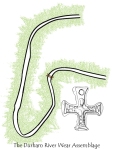our aims and objectives...
An overview of what we want to do...

background...

Aims...

Objectives...
(* Petts, D. 2015. Durham World Heritage Site - WHS Research Framework .pdf).
In order to achieve our key objectives...
The project will:
1) Adopt an interdisciplinary and thematic approach to record and research the thirteenth - eighteenth century objects of the DRWA using Department of Archaeology, Durham University students and artefact specialists.
2) Use crowd funding donations (monitored and moderated by the Architectural and Archaeological Society of Durham and Northumberland (AASDN)) to finance artefacts research and to commission object illustrations and photography.
3) Apply for match funding with public grants or private sponsorship to secure publication and other costs (i.e. the printing costs associated with a publication designed not only for those professionally engaged in small finds research, but also those with an amateur interest in history and archaeology).
4) Publish the medieval and post-medieval objects of the assemblage together with an artefact based narrative of Durham, in two volumes of a popular archaeology monograph series.
5) Developments in artefact typologies will be published in a popular archaeology monograph series. The use of unstratified assemblages as a research tool to describe historic social, economic and technical change will be published in an international journal.
6) Exhibit the assemblage in a number of museum venues and create a handling collection for loan to schools to enable the exchange of knowledge thus delivering civic, cultural and economic benefits.
7) We will make effective use of digital media to facilitate public and academic access to the whole assemblage through the Durham University Discover system.
8) Address new research questions exploring the survival, recovery and methods of presentation of artefacts in river beds.
9) To enlarge our contribution to the arts and deepen engagement with public and private partners, we will gift the entire Durham River Wear Assemblage to the 'citizens of Durham', thus ensuring the objects stay in County Durham under the stewardship of the Museum of Archaeology, Durham University.